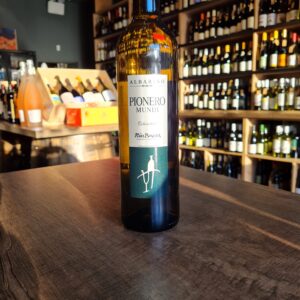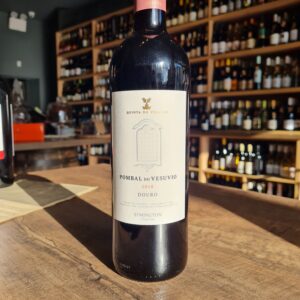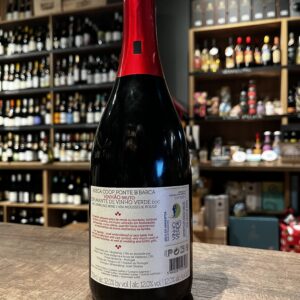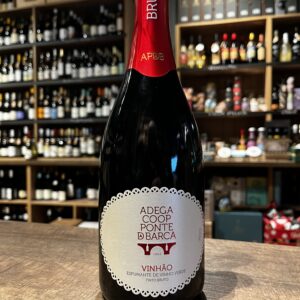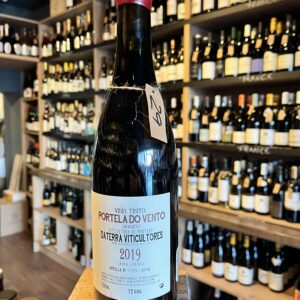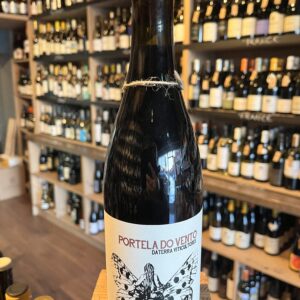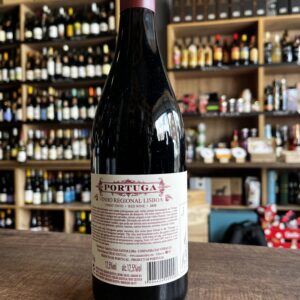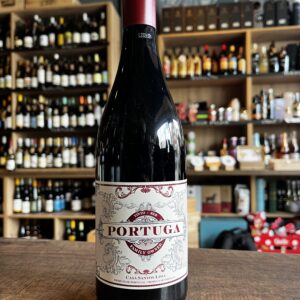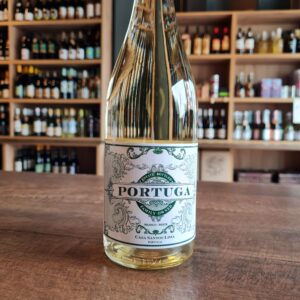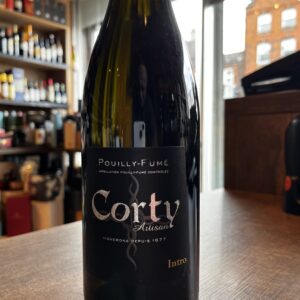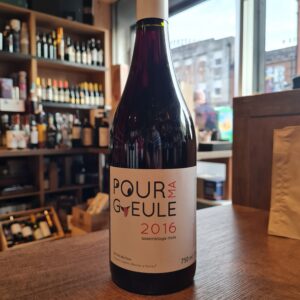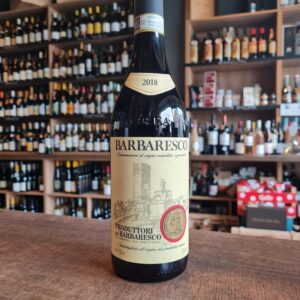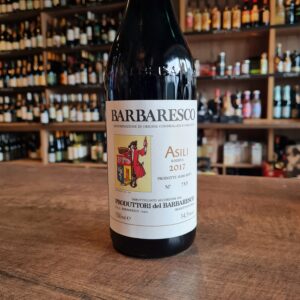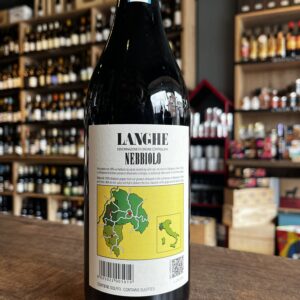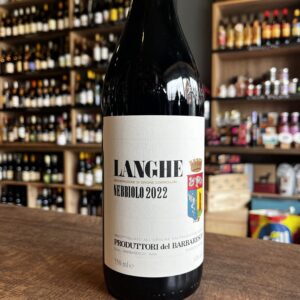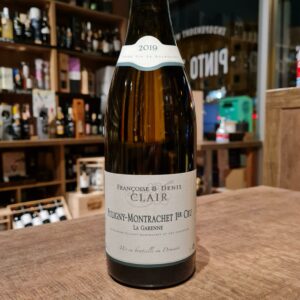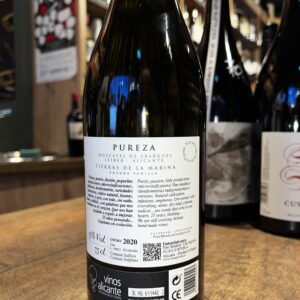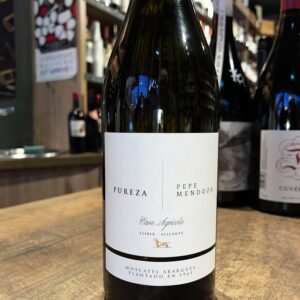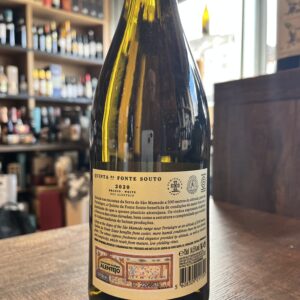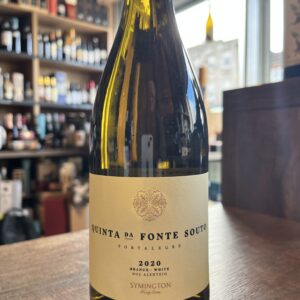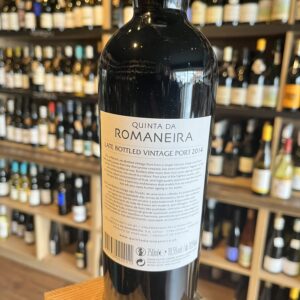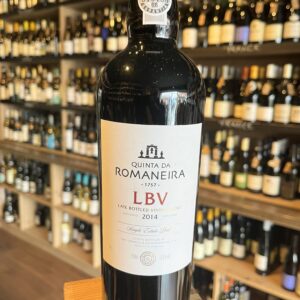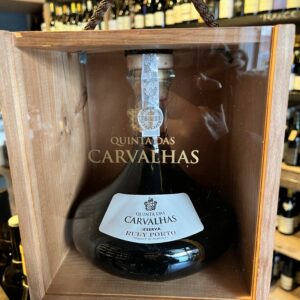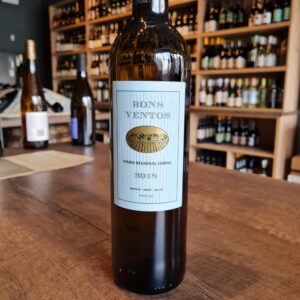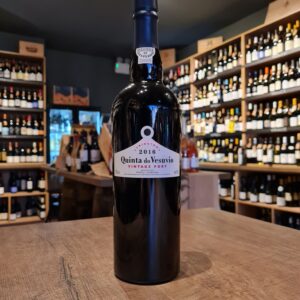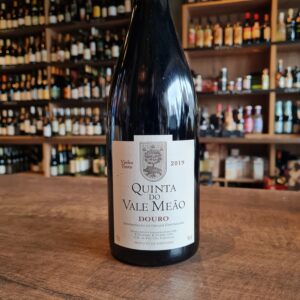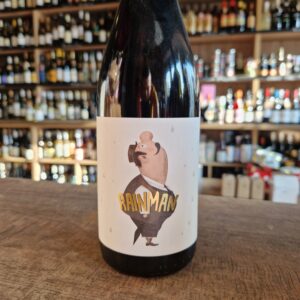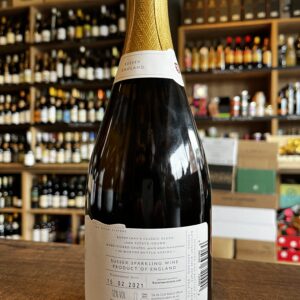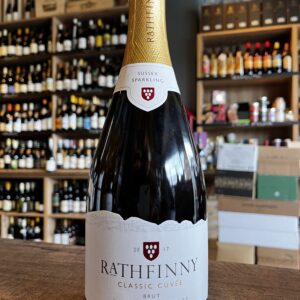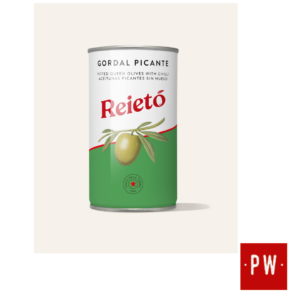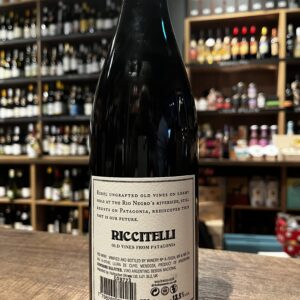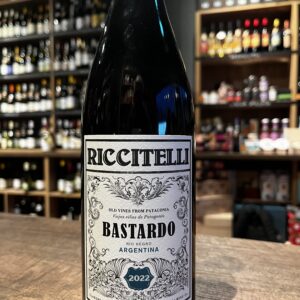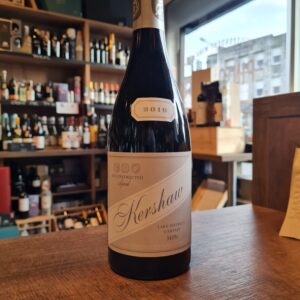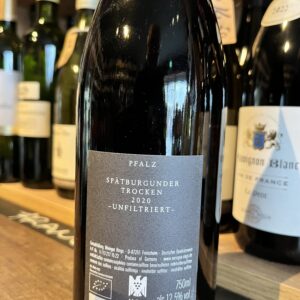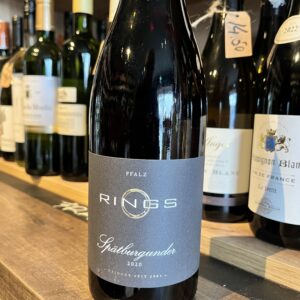-
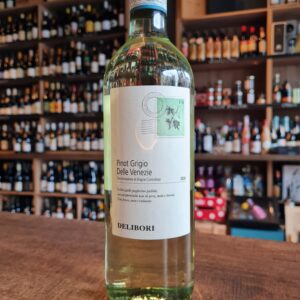 The Delibori Pinot Grigio delle Venezie impresses with its elegantly dry taste. It was bottled with exceptionally low residual sugar. This is a true quality wine, which clearly stands out from simpler qualities and so this Italian naturally enchants with the finest balance despite all dryness. Excellent taste does not necessarily require a lot of sugar. Light-footed and multi-layered, this light white wine presents itself on the palate. The final of this youthful white wine from the wine-growing region of Veneto, more precisely from Delle Venezie DOC, finally convinces with good reverberation. Best enjoyed moderately chilled at 11 - 13°C. It is perfect as an accompaniment to pumpkin casserole, vegetable stew with pesto or leek tortilla.
The Delibori Pinot Grigio delle Venezie impresses with its elegantly dry taste. It was bottled with exceptionally low residual sugar. This is a true quality wine, which clearly stands out from simpler qualities and so this Italian naturally enchants with the finest balance despite all dryness. Excellent taste does not necessarily require a lot of sugar. Light-footed and multi-layered, this light white wine presents itself on the palate. The final of this youthful white wine from the wine-growing region of Veneto, more precisely from Delle Venezie DOC, finally convinces with good reverberation. Best enjoyed moderately chilled at 11 - 13°C. It is perfect as an accompaniment to pumpkin casserole, vegetable stew with pesto or leek tortilla. -
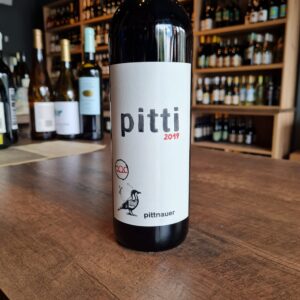 High on the hills of Austria there is more than just a lonely goat herd - there is also a fantastic winery, considered one of the country's best. Pittnauer has a long winemaking tradition in the region, and in 2006 moved to more biodynamic practices. The results are delicious, environmentally friendly wines with years of experience behind them. Now prepare yourself for some varieties you've probably never heard of - Pittnauer's Pitti Red Blend is made from blaufränkisch and Zweigelt grapes with a small quantity of Merlot added to the mixture. These varieties shine brightest in the Austrian climate, where they come together to make a stunningly delicious, full bodied wine reminiscent of spicy Shiraz. The ‘Pitti’ is a blend coming from vines that average 12-15 years in age and are planted on sandy clay mixed with limestone. Dark ruby in colour, the wine has tight tannins with black berries, cherries, cranberries and fresh acidic structure. Whispers of tobacco and liquorice. Ticks all the boxes of quality, drinkability and affordability and yumability.
High on the hills of Austria there is more than just a lonely goat herd - there is also a fantastic winery, considered one of the country's best. Pittnauer has a long winemaking tradition in the region, and in 2006 moved to more biodynamic practices. The results are delicious, environmentally friendly wines with years of experience behind them. Now prepare yourself for some varieties you've probably never heard of - Pittnauer's Pitti Red Blend is made from blaufränkisch and Zweigelt grapes with a small quantity of Merlot added to the mixture. These varieties shine brightest in the Austrian climate, where they come together to make a stunningly delicious, full bodied wine reminiscent of spicy Shiraz. The ‘Pitti’ is a blend coming from vines that average 12-15 years in age and are planted on sandy clay mixed with limestone. Dark ruby in colour, the wine has tight tannins with black berries, cherries, cranberries and fresh acidic structure. Whispers of tobacco and liquorice. Ticks all the boxes of quality, drinkability and affordability and yumability. -
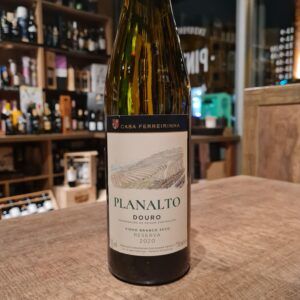 Planalto is one of the biggest references of white wine in the Douro Demarcated Region, fruit of the in-depth studies carried out over the years, the careful choice of the grape varieties that compose it and the use of the best winemaking technology in its production. This white blend comes from high-altitude vineyards above the river Douro. The soil in the Douro Valley is schistous; a slate-like metamorphic rock that fractures vertically - allowing vine roots to dig deep to access water and nutrients to sustain them through the hot Douro summers. The poor quality of the soil forces the grapes to produce low yields of grapes with a great concentration of flavour. The grapes were harvested by hand and were selected for their balance between flavour intensity and freshness. Ideal to accompany fish, seafood and white meat dishes.
Planalto is one of the biggest references of white wine in the Douro Demarcated Region, fruit of the in-depth studies carried out over the years, the careful choice of the grape varieties that compose it and the use of the best winemaking technology in its production. This white blend comes from high-altitude vineyards above the river Douro. The soil in the Douro Valley is schistous; a slate-like metamorphic rock that fractures vertically - allowing vine roots to dig deep to access water and nutrients to sustain them through the hot Douro summers. The poor quality of the soil forces the grapes to produce low yields of grapes with a great concentration of flavour. The grapes were harvested by hand and were selected for their balance between flavour intensity and freshness. Ideal to accompany fish, seafood and white meat dishes. -
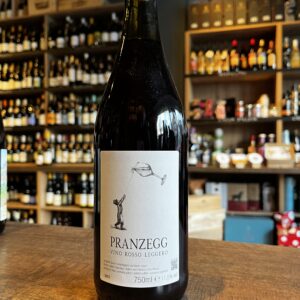 This is the kind of wine that all you need to do is to keep pouring! Delicious, joyuful, crunchy and always buy 2 as the first one will disappear. A playful and lively red that shows itself for what it is in every way: lots of fruit and some spice, a straight, agile and juicy mouthfeel, finesse, tension and elegance.
This is the kind of wine that all you need to do is to keep pouring! Delicious, joyuful, crunchy and always buy 2 as the first one will disappear. A playful and lively red that shows itself for what it is in every way: lots of fruit and some spice, a straight, agile and juicy mouthfeel, finesse, tension and elegance. -
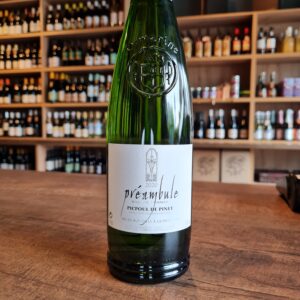 Picpoul de Pinet is a vivid illustration of just how dramatically white wine from the south of France has improved over recent years. Quite simply, the grape variety is Picpoul, or Piquepoul, which is grown around the village of Pinet, and other nearby villages, Florensac, Pomerols. Castelnau de Guers, Mèze and Montagnac. The vineyards form a surprising oasis of white wine in a sea of red wine. The terroir, or soil, explains the reason for this unexpected oasis of white wine. Quite simply the soil is too generous for red wine. It is mainly limestone, which suits white wine, with some clay, sand and appropriately a scattering of fossilised oyster shells. The climate is very much influenced by the sea, with a cooling effect during the nights of the hot summer months, and the vines benefit from maritime breezes. In somes cases it is fair to compare it to Muscadet. Neither packs a punch of flavour, but they provide brilliant accompaniments to the local seafood, and when finely crafted, have deliciously subtle flavours. The cooperative at Pinet, with its brand name L’Ormarine, and striking logo conveying the blue sea, green vines and yellow sun, are amongst the pacesetters of the appellation.
Picpoul de Pinet is a vivid illustration of just how dramatically white wine from the south of France has improved over recent years. Quite simply, the grape variety is Picpoul, or Piquepoul, which is grown around the village of Pinet, and other nearby villages, Florensac, Pomerols. Castelnau de Guers, Mèze and Montagnac. The vineyards form a surprising oasis of white wine in a sea of red wine. The terroir, or soil, explains the reason for this unexpected oasis of white wine. Quite simply the soil is too generous for red wine. It is mainly limestone, which suits white wine, with some clay, sand and appropriately a scattering of fossilised oyster shells. The climate is very much influenced by the sea, with a cooling effect during the nights of the hot summer months, and the vines benefit from maritime breezes. In somes cases it is fair to compare it to Muscadet. Neither packs a punch of flavour, but they provide brilliant accompaniments to the local seafood, and when finely crafted, have deliciously subtle flavours. The cooperative at Pinet, with its brand name L’Ormarine, and striking logo conveying the blue sea, green vines and yellow sun, are amongst the pacesetters of the appellation. -
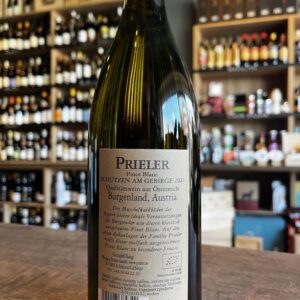
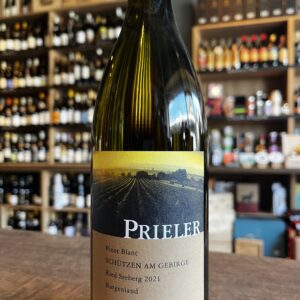 Old vines are the fortune of every vintner. They root deeply and lend their intrinsic potential a persistent voice. Pinot Blanc, also locally called Weissburgunder, has a long tradition in our region. My grandfather planted most of our vines in the limestone of the Seeberg site 60 years ago. A few were even planted by my grandfather over 90 years ago. It is my duty today to continue to tell the story that the two of them began.
Old vines are the fortune of every vintner. They root deeply and lend their intrinsic potential a persistent voice. Pinot Blanc, also locally called Weissburgunder, has a long tradition in our region. My grandfather planted most of our vines in the limestone of the Seeberg site 60 years ago. A few were even planted by my grandfather over 90 years ago. It is my duty today to continue to tell the story that the two of them began. -
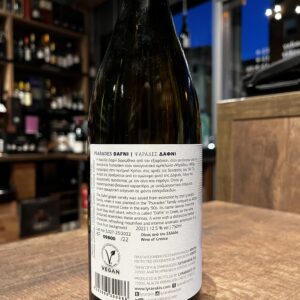
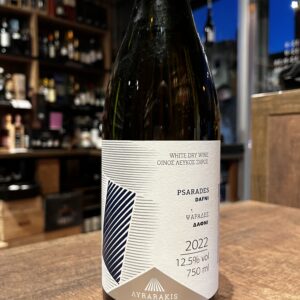 The Dafni grape variety was saved from extiction by the Lyrarakis family, when it was planted in the ''Psarades'' family vineyard at 480m altitude in central Crete in the early 90's. It's name derives from the laurel (bay leaf) plant, which its called ''Dafni'' in Greek, as the wines produced resembles these aromas. Pair with fried small Fish, seafood like cuttlefish with spinach, white meat, pulses and pies with greens and aromatic herbs
The Dafni grape variety was saved from extiction by the Lyrarakis family, when it was planted in the ''Psarades'' family vineyard at 480m altitude in central Crete in the early 90's. It's name derives from the laurel (bay leaf) plant, which its called ''Dafni'' in Greek, as the wines produced resembles these aromas. Pair with fried small Fish, seafood like cuttlefish with spinach, white meat, pulses and pies with greens and aromatic herbs -
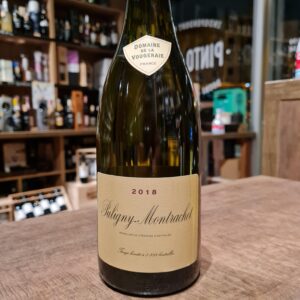 Domaine de La Vougeraie is born from the assembly of domains acquired over time and the vines of the family. Its history dates back to 1964 with the first vine, Les Evocelles, acquired by our father at his very beginnings. Here, it is in his village that he will have his first lands around Gevrey-Chambertin. The reputation of Domaine de la Vougeraie is well established. This area of excellence is located in Premeaux-Prissey, a small village in Burgundy , near Nuits-Saint-Georges, in the Côte de Nuits . For this cuvée, the estate brings together two small plots in the “ La Rue aux Vaches ” and “ Noyer Bret ” climates . They are planted with Chardonnay and worked in biodynamics , homeopathy applied to the vine. 2018 was a generous, sunny vintage, which managed to maintain a good level of freshness Sylvie Poillot, General Manager, farms the estate’s 42 hectares biodynamically. “We do this to preserve the fertility of soils, and to have a very good balance between the soil and the plant’s health,” she explains. It’s not just the soil health that’s changed: two decades on from their conversion to biodynamics, the wines are evolving too: “The wines are more aromatic and more expressive year after year,” she says. A fascinating 2018: on the one hand, it’s opulent with the warmth of the vintage; on the other, it’s tight with typical Puligny fruit, stone and bite. A superior example. Drink 2022-2028 Great with grilled fish, scallops, lobster, lobster
Domaine de La Vougeraie is born from the assembly of domains acquired over time and the vines of the family. Its history dates back to 1964 with the first vine, Les Evocelles, acquired by our father at his very beginnings. Here, it is in his village that he will have his first lands around Gevrey-Chambertin. The reputation of Domaine de la Vougeraie is well established. This area of excellence is located in Premeaux-Prissey, a small village in Burgundy , near Nuits-Saint-Georges, in the Côte de Nuits . For this cuvée, the estate brings together two small plots in the “ La Rue aux Vaches ” and “ Noyer Bret ” climates . They are planted with Chardonnay and worked in biodynamics , homeopathy applied to the vine. 2018 was a generous, sunny vintage, which managed to maintain a good level of freshness Sylvie Poillot, General Manager, farms the estate’s 42 hectares biodynamically. “We do this to preserve the fertility of soils, and to have a very good balance between the soil and the plant’s health,” she explains. It’s not just the soil health that’s changed: two decades on from their conversion to biodynamics, the wines are evolving too: “The wines are more aromatic and more expressive year after year,” she says. A fascinating 2018: on the one hand, it’s opulent with the warmth of the vintage; on the other, it’s tight with typical Puligny fruit, stone and bite. A superior example. Drink 2022-2028 Great with grilled fish, scallops, lobster, lobster -
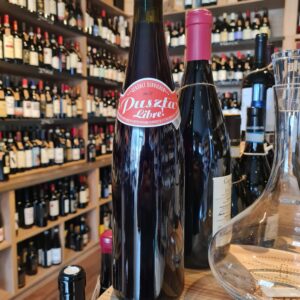 Claus Preisinger made his first wine when he was just 20 years old and quickly expanded the 3 hectares of his family vineyards by the Neusiedlersee lake in Burgenland (Austria) to 19 ha. He is the youngest member of Pannobile, a group created to champion the unique character of Burgenland’s terroir and local varieties, and a promising new Austrian producer. Puszta Libre! comes from vineyards lying on the north shore of Lake Neusiedl on very varied sandy loam soils, with flint, quartz, slate and limestone. Basing his work Rudolf Steiner's biodynamic principles, he maintains the natural balance of the vineyard using only organic and biodynamic practices. Puszta Libre! is a tribute to ancient viticulture both in the way it is made and in the way it is presented. Its design is inspired by classic soft drinks and invites you to drink it cold and without preconceived ideas. Drink slighly chilled and with your mates!
Claus Preisinger made his first wine when he was just 20 years old and quickly expanded the 3 hectares of his family vineyards by the Neusiedlersee lake in Burgenland (Austria) to 19 ha. He is the youngest member of Pannobile, a group created to champion the unique character of Burgenland’s terroir and local varieties, and a promising new Austrian producer. Puszta Libre! comes from vineyards lying on the north shore of Lake Neusiedl on very varied sandy loam soils, with flint, quartz, slate and limestone. Basing his work Rudolf Steiner's biodynamic principles, he maintains the natural balance of the vineyard using only organic and biodynamic practices. Puszta Libre! is a tribute to ancient viticulture both in the way it is made and in the way it is presented. Its design is inspired by classic soft drinks and invites you to drink it cold and without preconceived ideas. Drink slighly chilled and with your mates! -
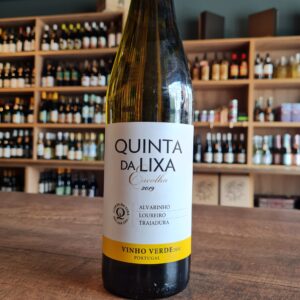 This wine is made from the noblest and best known Portuguese grape variety(Alvarinho), in a year of exceptional quality. The aroma is intense and very attractive, with flowery and fruity notes, and lemonade hints, in a combination of great character and fineness. Tropical fruit in the mouth, acidity fits nicely with the fruit. Long finish
This wine is made from the noblest and best known Portuguese grape variety(Alvarinho), in a year of exceptional quality. The aroma is intense and very attractive, with flowery and fruity notes, and lemonade hints, in a combination of great character and fineness. Tropical fruit in the mouth, acidity fits nicely with the fruit. Long finish -
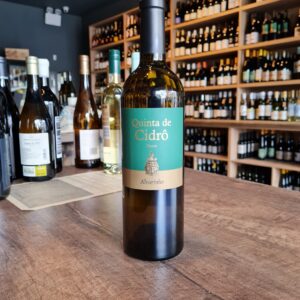 Quinta de Cidrô presents the first Alvarinho produced in the Douro, another superb result of the continuous innovation that takes place in the vineyards of the property. The idea to plant Alvarinho in the Douro came from their ambition to produce a high quality white monovarietal from a Portuguese grape variety. A wine marked by fine and delicate aromas of citrus fruit and orange blossom, which presents an excellent aromatic complexity. Expressive and personalized, it is above all a full-bodied Douro wine, revealing flavours that can be guessed at in the aroma. A long and distinct Alvarinho, determined by a crisp acidity and a tasty minerality.
Quinta de Cidrô presents the first Alvarinho produced in the Douro, another superb result of the continuous innovation that takes place in the vineyards of the property. The idea to plant Alvarinho in the Douro came from their ambition to produce a high quality white monovarietal from a Portuguese grape variety. A wine marked by fine and delicate aromas of citrus fruit and orange blossom, which presents an excellent aromatic complexity. Expressive and personalized, it is above all a full-bodied Douro wine, revealing flavours that can be guessed at in the aroma. A long and distinct Alvarinho, determined by a crisp acidity and a tasty minerality. -
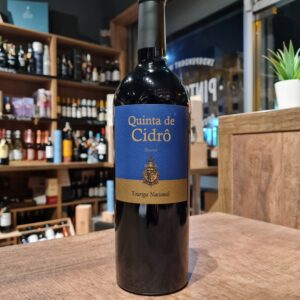 I have been chasing a 100% Touriga Nacional for a while now, with some disappointments in the middle. Mostly due to knowing the full potential of Touriga Nacional and what can be done with it. Was loosing faith(Poor supplier offering in Ireland) and was actively looking to import myself a few options until I stumbled upon this gem. This wine is the example where no one should judge a book by its cover. Across all Companhia Velha Wines the labels are just minimal, classy but not in the way you would think. Has a bit of I don't give a damn about them and that subtlety actually impresses me even further. No distractions to be added here!!! Bear in mind this winery was one of the first if not the first Wine family business(1756) in the Douro Valley(1763) and it was full integrated when it became the first official wine region in the world. Quinta de Cidrô is located at São João da Pesqueira, which is one of the most highly regarded areas of Douro Valley. Throughout the last 20 years, Cidrô has been transformed into an experimental-model vineyard for the entire region. In virgin soils, cutting edge techniques were employed to plant 150 ha of the best varieties, creating one of the largest surfaces of single vineyard in the entire Douro Region. In the most privileged location, international varieties perform equally well as the local grapes. Chardonnay, Sauvignon Blanc, Viognier, Pinot Noir, and the adaptable Cabernet Sauvignon are some of the foreign varieties that here express their best qualities when vinified by the extensive winemaking know-how present at the Company. Touriga Nacional is Portugal’s star variety and the dominant red grape at Quinta de Cidrô. The altitude of this Quinta provides excellent freshness and levels of acidity, ideal conditions for an elegant red wine. Touriga Nacional is a versatile grape, with its main characteristics being the small bundle, its low yield and jagged leaf. Its presence in the vines is intimidating, as it requires a constant care for its wild and rebellious character of growing disorderly. At Quinta de Cidrô, Touriga Nacional was adapted to a less habitual place, as it was mostly planted in low altitude vineyards and subject to high temperatures; the opposite of Quinta de Cidrô. Personally I love it on its own with at least 45 minutes decanting or enjoy really slow the very first drop. Winemakers suggestion for this stunning wine are: Rump Steak, Pork Leg, Parmigiano Cheese and Dark Chocolate.
I have been chasing a 100% Touriga Nacional for a while now, with some disappointments in the middle. Mostly due to knowing the full potential of Touriga Nacional and what can be done with it. Was loosing faith(Poor supplier offering in Ireland) and was actively looking to import myself a few options until I stumbled upon this gem. This wine is the example where no one should judge a book by its cover. Across all Companhia Velha Wines the labels are just minimal, classy but not in the way you would think. Has a bit of I don't give a damn about them and that subtlety actually impresses me even further. No distractions to be added here!!! Bear in mind this winery was one of the first if not the first Wine family business(1756) in the Douro Valley(1763) and it was full integrated when it became the first official wine region in the world. Quinta de Cidrô is located at São João da Pesqueira, which is one of the most highly regarded areas of Douro Valley. Throughout the last 20 years, Cidrô has been transformed into an experimental-model vineyard for the entire region. In virgin soils, cutting edge techniques were employed to plant 150 ha of the best varieties, creating one of the largest surfaces of single vineyard in the entire Douro Region. In the most privileged location, international varieties perform equally well as the local grapes. Chardonnay, Sauvignon Blanc, Viognier, Pinot Noir, and the adaptable Cabernet Sauvignon are some of the foreign varieties that here express their best qualities when vinified by the extensive winemaking know-how present at the Company. Touriga Nacional is Portugal’s star variety and the dominant red grape at Quinta de Cidrô. The altitude of this Quinta provides excellent freshness and levels of acidity, ideal conditions for an elegant red wine. Touriga Nacional is a versatile grape, with its main characteristics being the small bundle, its low yield and jagged leaf. Its presence in the vines is intimidating, as it requires a constant care for its wild and rebellious character of growing disorderly. At Quinta de Cidrô, Touriga Nacional was adapted to a less habitual place, as it was mostly planted in low altitude vineyards and subject to high temperatures; the opposite of Quinta de Cidrô. Personally I love it on its own with at least 45 minutes decanting or enjoy really slow the very first drop. Winemakers suggestion for this stunning wine are: Rump Steak, Pork Leg, Parmigiano Cheese and Dark Chocolate. -
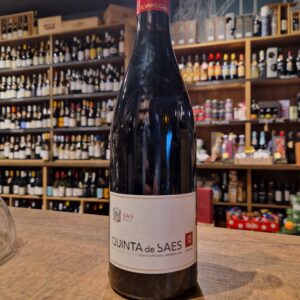 Dão is quickly becoming the most sought-after region for Portuguese winemakers to venture into; according to many, it’s one of the world’s most perfect microclimates: mountains protect it from continental heat to the east and Douro’s heat to north, and cool Atlantic breezes come inland to keep the overall temperatures more regulated, making for wines with bright acidity, ethereal aromatics, and compelling complexity. The DO’s granitic soils allow indigenous grapes to shine through in the wines, and provide firm, crunchy tannin against the bright fruit. Alvaro Castro has noted that “if God were to design a wine-growing region, what he would come up with would look a lot like the Dão.” There is no modern Dão without one of the region’s longtime legends, Alvaro Castro, whose estate encompasses two small properties (or “quintas”) known as Pellada and Saes. Alvaro makes wine here with his daughter Maria, carrying on a tradition of winemaking on this property that dates to the 16th century! Together, they have resisted the internationalization push of the ‘80s and ‘90s, instead doubling down on their slow-wine approach, using local varieties grown and crafted in the true Dāo “field blend” style. The Dão is home to the finest plantings of Touriga Naçional in Portugal. The microclimate that protects it from the extreme heat of the eastern winds and the overly wet conditions to the north and west provides a cool, temperate setting for Touriga to showcase its hallmark rose petal aromatics and soft fruit. Aged in neutral oak, this is a pure, unadulterated expression of Dão Touriga. Average age of 15 years. Tended in granite and clay soil at 550m (1811ft) elevation. Pair with roast pork, lighter game like rabbit and quail, and mushroom dishes.
Dão is quickly becoming the most sought-after region for Portuguese winemakers to venture into; according to many, it’s one of the world’s most perfect microclimates: mountains protect it from continental heat to the east and Douro’s heat to north, and cool Atlantic breezes come inland to keep the overall temperatures more regulated, making for wines with bright acidity, ethereal aromatics, and compelling complexity. The DO’s granitic soils allow indigenous grapes to shine through in the wines, and provide firm, crunchy tannin against the bright fruit. Alvaro Castro has noted that “if God were to design a wine-growing region, what he would come up with would look a lot like the Dão.” There is no modern Dão without one of the region’s longtime legends, Alvaro Castro, whose estate encompasses two small properties (or “quintas”) known as Pellada and Saes. Alvaro makes wine here with his daughter Maria, carrying on a tradition of winemaking on this property that dates to the 16th century! Together, they have resisted the internationalization push of the ‘80s and ‘90s, instead doubling down on their slow-wine approach, using local varieties grown and crafted in the true Dāo “field blend” style. The Dão is home to the finest plantings of Touriga Naçional in Portugal. The microclimate that protects it from the extreme heat of the eastern winds and the overly wet conditions to the north and west provides a cool, temperate setting for Touriga to showcase its hallmark rose petal aromatics and soft fruit. Aged in neutral oak, this is a pure, unadulterated expression of Dão Touriga. Average age of 15 years. Tended in granite and clay soil at 550m (1811ft) elevation. Pair with roast pork, lighter game like rabbit and quail, and mushroom dishes. -
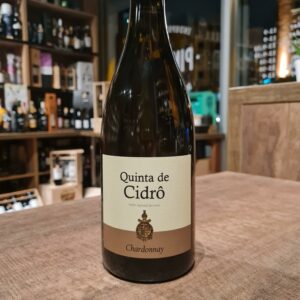 Quinta de Cidrô is located at São João da Pesqueira, which is one of the most highly regarded areas of Douro Valley. Throughout the last 20 years, Cidrô has been transformed into an experimental-model vineyard for the entire region. In virgin soils, cutting edge techniques were employed to plant 150 ha of the best varieties, creating one of the largest surfaces of single vineyard in the entire Douro Region. In the most privileged location, international varieties perform equally well as the local grapes. Chardonnay, Sauvignon Blanc, Viognier, Pinot Noir, and the adaptable Cabernet Sauvignon are some of the foreign varieties that here express their best qualities when vinified by the extensive winemaking know-how present at the Company. The Quinta de Cidrô Sauvignon Blanc was the second result of the ongoing experimentation-taking place at this vineyard.
Quinta de Cidrô is located at São João da Pesqueira, which is one of the most highly regarded areas of Douro Valley. Throughout the last 20 years, Cidrô has been transformed into an experimental-model vineyard for the entire region. In virgin soils, cutting edge techniques were employed to plant 150 ha of the best varieties, creating one of the largest surfaces of single vineyard in the entire Douro Region. In the most privileged location, international varieties perform equally well as the local grapes. Chardonnay, Sauvignon Blanc, Viognier, Pinot Noir, and the adaptable Cabernet Sauvignon are some of the foreign varieties that here express their best qualities when vinified by the extensive winemaking know-how present at the Company. The Quinta de Cidrô Sauvignon Blanc was the second result of the ongoing experimentation-taking place at this vineyard. -
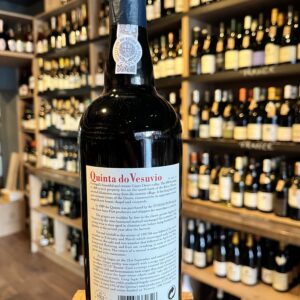
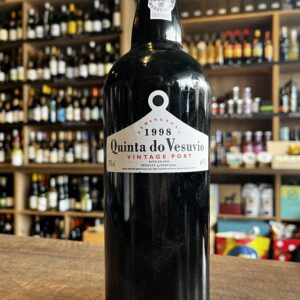 A Vintage Port is only declared in years of exceptional quality. Quinta do Vesuvio is arguably the most magnificent estate in the Douro valley. Located in the beautiful and austere Port-growing region of the Upper Douro valley, its history dates back to the 16th Century. “The quinta of all quintas – one of the wonders of the world”. At Vesuvio, the work of man and the work of nature achieve a perfect and enduring harmony. More than anywhere else in the Douro it has a haunting and enchanting beauty; when you leave it, you take with you a sense of the place that does not fade with time.
A Vintage Port is only declared in years of exceptional quality. Quinta do Vesuvio is arguably the most magnificent estate in the Douro valley. Located in the beautiful and austere Port-growing region of the Upper Douro valley, its history dates back to the 16th Century. “The quinta of all quintas – one of the wonders of the world”. At Vesuvio, the work of man and the work of nature achieve a perfect and enduring harmony. More than anywhere else in the Douro it has a haunting and enchanting beauty; when you leave it, you take with you a sense of the place that does not fade with time. -
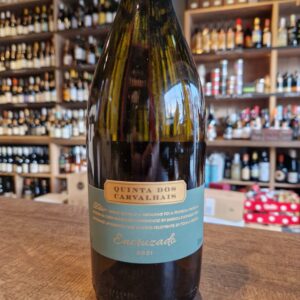 Sogrape Vinhos was founded in 1942 by Fernando van Zeller Guedes, with the ambition of making Portuguese wines known to the world and a long-term vision based on the quality of the wines to be marketed, the importance of the novelty of the brands, and the presentation of its wines. Today, led by the third generation of the founding family, Sogrape Vinhos is increasingly faithful to the goal it has had since it was founded: to be a family-owned company with an international vocation, focused on the production of quality wines, on innovation, and the development of global Portuguese brands. Sogrape Vinhos has about 830 hectares of vineyards in Portugal. Quinta dos Carvalhais is located in the municipality of Mangualde, near Nelas and Alcafache. The soil, the climate, the experience of those who have always produced wine make the Dão truly special. This 105-hectare estate, situated at an altitude of 465-500 metres, has 50 hectares under vine on predominantly granite soils. Warm days and cool nights at this altitude slow down the grape ripening process and result in wines with lovely depth yet vibrant fruit and a signature freshness. Precision viticulture is carried out on the estate with a multitude of different plots matched to specific grape varieties and harvested at different times. The fruit for the 2021 Encruzado was sourced from four different plots. Two cooler plots, one next to the lake on the estate and another often shaded by the oak trees, deliver a vibrant acidity the blend. Another plot with more sandy soils produces intensely aromatic grapes. All of the vineyards are farmed sustainably and harvesting is carried out by hand.
Sogrape Vinhos was founded in 1942 by Fernando van Zeller Guedes, with the ambition of making Portuguese wines known to the world and a long-term vision based on the quality of the wines to be marketed, the importance of the novelty of the brands, and the presentation of its wines. Today, led by the third generation of the founding family, Sogrape Vinhos is increasingly faithful to the goal it has had since it was founded: to be a family-owned company with an international vocation, focused on the production of quality wines, on innovation, and the development of global Portuguese brands. Sogrape Vinhos has about 830 hectares of vineyards in Portugal. Quinta dos Carvalhais is located in the municipality of Mangualde, near Nelas and Alcafache. The soil, the climate, the experience of those who have always produced wine make the Dão truly special. This 105-hectare estate, situated at an altitude of 465-500 metres, has 50 hectares under vine on predominantly granite soils. Warm days and cool nights at this altitude slow down the grape ripening process and result in wines with lovely depth yet vibrant fruit and a signature freshness. Precision viticulture is carried out on the estate with a multitude of different plots matched to specific grape varieties and harvested at different times. The fruit for the 2021 Encruzado was sourced from four different plots. Two cooler plots, one next to the lake on the estate and another often shaded by the oak trees, deliver a vibrant acidity the blend. Another plot with more sandy soils produces intensely aromatic grapes. All of the vineyards are farmed sustainably and harvesting is carried out by hand. -
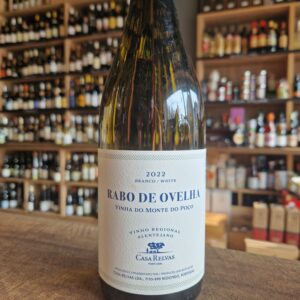 Casa Relvas is a family project, started in 1997 in São Miguel de Machede, in Redondo, by Alexandre Relvas, which aims to continue the history of five generations with a strong passion for the Alentejo and its genuine nature. Over the years, the family has grown along with the business and it didn't take long for it to total about 750 hectares of Montado forest, 225 hectares of olive groves, and 350 hectares of 100% integrated production vineyards. With the three estates - Herdade de São Miguel, Herdade da Pimenta and Herdade de São Miguel de Machede - Casa Relvas has the capacity to produce 6 million bottles of wine annually, 70% of which is to meet the needs of the foreign market, being present in over 30 countries worldwide, offering the best of the Alentejo.
Casa Relvas is a family project, started in 1997 in São Miguel de Machede, in Redondo, by Alexandre Relvas, which aims to continue the history of five generations with a strong passion for the Alentejo and its genuine nature. Over the years, the family has grown along with the business and it didn't take long for it to total about 750 hectares of Montado forest, 225 hectares of olive groves, and 350 hectares of 100% integrated production vineyards. With the three estates - Herdade de São Miguel, Herdade da Pimenta and Herdade de São Miguel de Machede - Casa Relvas has the capacity to produce 6 million bottles of wine annually, 70% of which is to meet the needs of the foreign market, being present in over 30 countries worldwide, offering the best of the Alentejo. -
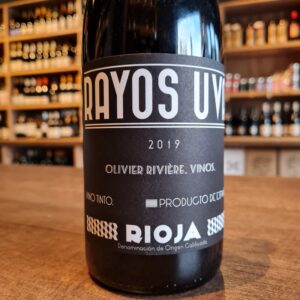 Olivier Riviere, founder and winemaker at Rayos Uva Rioja, is originally from Cognac. He studied in St-Emilion and then made wine in southern France and Burgundy before moving to Ribera del Duero in 2004, when he started leasing land and purchasing fruit for his new Spanish blends. Finally, in 2013, Olivier bought his first 3.5 acres in Rioja Alavesa; Rayos Uva is now in its sixth vintage. Olivier's holdings are substantially larger now, but he still sources fruit from his favorite bodegas. Grown by Bodegas Lacus where Olivier is also the winemaker, this 2021 is a blend of hand-harvested Tempranillo and Graciano that is semi-carbonically fermented in tanks with wild yeasts. Aged 10-12 months in tank and concrete foudre. An exciting Rioja with a French artisanal sensibility. Slightly filtered. It is recommended to open the bottle half an hour before consuming it to express the true potential.
Olivier Riviere, founder and winemaker at Rayos Uva Rioja, is originally from Cognac. He studied in St-Emilion and then made wine in southern France and Burgundy before moving to Ribera del Duero in 2004, when he started leasing land and purchasing fruit for his new Spanish blends. Finally, in 2013, Olivier bought his first 3.5 acres in Rioja Alavesa; Rayos Uva is now in its sixth vintage. Olivier's holdings are substantially larger now, but he still sources fruit from his favorite bodegas. Grown by Bodegas Lacus where Olivier is also the winemaker, this 2021 is a blend of hand-harvested Tempranillo and Graciano that is semi-carbonically fermented in tanks with wild yeasts. Aged 10-12 months in tank and concrete foudre. An exciting Rioja with a French artisanal sensibility. Slightly filtered. It is recommended to open the bottle half an hour before consuming it to express the true potential. -
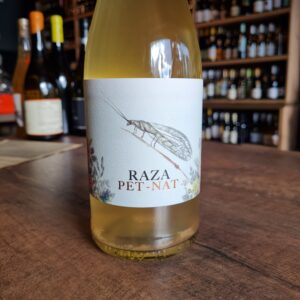 The concept of this label is to send the consumer to the botanical universe of the XVI century. A very unique style which is a tribute to nature and the living beings who look after it so well. A mixture of charcoal pencils with watercolor provides fresh, traditional, and natural air. The informative label on the side of the bottle is drawn in a vintage style referencing this era's aesthetics. The Lacewing or Chrysoperla (Raza)represents their holistic approach to viticulture. Its efficiency in biological control pest is remarkable and helps keep the vines free of pests.Pet Nat is an abbreviation for Pétillant Naturel, a naturally sparkling wine. The fermented wine is still bottled in the bottle, which stops the fermentation there, so a little CO2 and yeast precipitate is formed in the bottle. The wine is not cleaned, sweetened (no dosage) and the wine is now closed with a regular crown cap. The wine is made with natural yeast and uses minimal sulphites. Spontaneous fermentation ends in the bottle, as a result of which a pleasantly natural layer remains in the wine. This refreshing, sparkling wine is full of fruity and lively orchard flavors. The natural sediment makes the wine cloudy, while adding many interesting nuances to the taste, the wild yeast makes the wine tasty and easy to enjoy.
The concept of this label is to send the consumer to the botanical universe of the XVI century. A very unique style which is a tribute to nature and the living beings who look after it so well. A mixture of charcoal pencils with watercolor provides fresh, traditional, and natural air. The informative label on the side of the bottle is drawn in a vintage style referencing this era's aesthetics. The Lacewing or Chrysoperla (Raza)represents their holistic approach to viticulture. Its efficiency in biological control pest is remarkable and helps keep the vines free of pests.Pet Nat is an abbreviation for Pétillant Naturel, a naturally sparkling wine. The fermented wine is still bottled in the bottle, which stops the fermentation there, so a little CO2 and yeast precipitate is formed in the bottle. The wine is not cleaned, sweetened (no dosage) and the wine is now closed with a regular crown cap. The wine is made with natural yeast and uses minimal sulphites. Spontaneous fermentation ends in the bottle, as a result of which a pleasantly natural layer remains in the wine. This refreshing, sparkling wine is full of fruity and lively orchard flavors. The natural sediment makes the wine cloudy, while adding many interesting nuances to the taste, the wild yeast makes the wine tasty and easy to enjoy. -
 For those red wine lovers. You know what I mean by red lips! We brought together for you a red wine case of 6 bottles full of character, lavish richness, booming dark fruits, warming spice flavours, and velvet-smooth down to the very last drop. With this case you will travel from Portugal, Spain through France and Italy all the way to California. No doubt you will develop some red wine lips... Lab Tinto Lisboa - Lab tested and Lab approved! Full bodied, red produced on the coast of Lisbon, is smooth and is very aromatic with notes of ripe black and red fruits. On the palate, juicy plums and dark berry fruit flavour with plenty of fresh yet fine tannins that take over at the finish, along with flavours of spice and liquorice. It is not a top shelf wine but it does punch above its weight. Michel Chapoutier Marius - As Marius, Michel Chapoutier’s great-grandfather, always said ‘A good wine is one that beckons us to take another sip’. This wine carries this message and reflects the warmth of the southern french terroirs in which they are rooted. Dark red, dense, clear wine with deep purple shimmer. On the nose: powerful, complex, dark, spicy, red berries, delicate floral note. Château Haut Gravelier - Château Gravelier is located on superb hillsides on the edge of Entre Deux Mers, Bordeaux. Classic French blend of 70% Merlot 30% Cabernet Sauvignon. With deep colour, classic structure and unusually ripe flavours, this is classic claret to serve with roast beef, duck or T-bone steak. Palacio del Camino Crianza Rioja - The simple enjoyment of a really good Rioja is sometimes forgotten. But here one is, great with food, but honestly, just as great in a large glass on a sofa with nowhere to be and nothing to do. An elegant fruity wine with vanilla, spices and red fruit. Monte del Frá Bardolino DOC - This charming and typical red wine from Veneto is a cuvée made from 65% Corvina, 30% Rondinella and 5% Sangiovese, the usual suspects as Italian red grape varieties go. On the nose exudes aromas of different types of cherries, raspberries and strawberries. A whole range of spicy overtones and undertones play around this fruity core: cloves, cinnamon, violets and pepper. Tannins and fruit acid are perfectly coordinated. In the finale, some more cinnamon and black pepper. I would pair this one with pasta or your favourite comfort food. Beringer Zinfandel California - A Zin that definitely portrays some Classic California ripeness. Ripe blueberries, blackberries, plums, a hint of smoky and mineral characters and a touch perfumed (dried floral notes) on the nose. On the palate you'll find that smoke and berry ripeness coming through, with a little tangy raspberry adding to a lengthy finish. Medium plus body with a silky mouthfeel, smooth light tannins and luscious acidity. I love Zins with a juicy bacon and smoked cheddar burger or with your favourite pizza. This one should not disappoint!
For those red wine lovers. You know what I mean by red lips! We brought together for you a red wine case of 6 bottles full of character, lavish richness, booming dark fruits, warming spice flavours, and velvet-smooth down to the very last drop. With this case you will travel from Portugal, Spain through France and Italy all the way to California. No doubt you will develop some red wine lips... Lab Tinto Lisboa - Lab tested and Lab approved! Full bodied, red produced on the coast of Lisbon, is smooth and is very aromatic with notes of ripe black and red fruits. On the palate, juicy plums and dark berry fruit flavour with plenty of fresh yet fine tannins that take over at the finish, along with flavours of spice and liquorice. It is not a top shelf wine but it does punch above its weight. Michel Chapoutier Marius - As Marius, Michel Chapoutier’s great-grandfather, always said ‘A good wine is one that beckons us to take another sip’. This wine carries this message and reflects the warmth of the southern french terroirs in which they are rooted. Dark red, dense, clear wine with deep purple shimmer. On the nose: powerful, complex, dark, spicy, red berries, delicate floral note. Château Haut Gravelier - Château Gravelier is located on superb hillsides on the edge of Entre Deux Mers, Bordeaux. Classic French blend of 70% Merlot 30% Cabernet Sauvignon. With deep colour, classic structure and unusually ripe flavours, this is classic claret to serve with roast beef, duck or T-bone steak. Palacio del Camino Crianza Rioja - The simple enjoyment of a really good Rioja is sometimes forgotten. But here one is, great with food, but honestly, just as great in a large glass on a sofa with nowhere to be and nothing to do. An elegant fruity wine with vanilla, spices and red fruit. Monte del Frá Bardolino DOC - This charming and typical red wine from Veneto is a cuvée made from 65% Corvina, 30% Rondinella and 5% Sangiovese, the usual suspects as Italian red grape varieties go. On the nose exudes aromas of different types of cherries, raspberries and strawberries. A whole range of spicy overtones and undertones play around this fruity core: cloves, cinnamon, violets and pepper. Tannins and fruit acid are perfectly coordinated. In the finale, some more cinnamon and black pepper. I would pair this one with pasta or your favourite comfort food. Beringer Zinfandel California - A Zin that definitely portrays some Classic California ripeness. Ripe blueberries, blackberries, plums, a hint of smoky and mineral characters and a touch perfumed (dried floral notes) on the nose. On the palate you'll find that smoke and berry ripeness coming through, with a little tangy raspberry adding to a lengthy finish. Medium plus body with a silky mouthfeel, smooth light tannins and luscious acidity. I love Zins with a juicy bacon and smoked cheddar burger or with your favourite pizza. This one should not disappoint! -
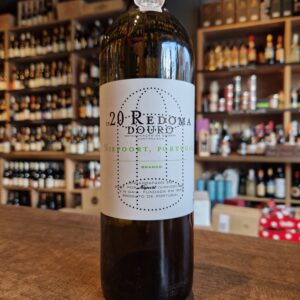 This oaky white will appeal to Graves or Burgundy lovers. The grapes used for the Redoma Branco originate from old vines growing on the right bank of the Douro River, at an altitude of between 400 and 600 metres. These vines predominantly grow in mica-schist soils, which, in combination with the complexity of the various grape varieties typical of the Douro region, create delicate wines full of freshness and minerality. Food suggestions-Oysters, oven-baked fish, poultry and other white meats. Vegetarian options: dishes based on root vegetables (turnips, sweet potato, beetroot), Caesar salad, cheese.
This oaky white will appeal to Graves or Burgundy lovers. The grapes used for the Redoma Branco originate from old vines growing on the right bank of the Douro River, at an altitude of between 400 and 600 metres. These vines predominantly grow in mica-schist soils, which, in combination with the complexity of the various grape varieties typical of the Douro region, create delicate wines full of freshness and minerality. Food suggestions-Oysters, oven-baked fish, poultry and other white meats. Vegetarian options: dishes based on root vegetables (turnips, sweet potato, beetroot), Caesar salad, cheese. -
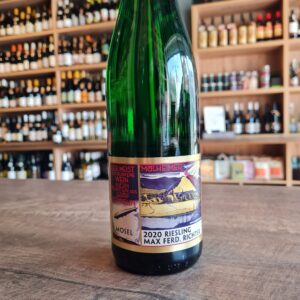 Max Ferdinand Richter winery produces this classic off-dry Mosel Riesling from the Mulheimer Sonnenlay vineyard. The bottle features a beautiful Art Deco label depicting the Zeppelin airships upon which this Riesling was served in the 1920's and 30's. "The Mülheimer Sonnenlay is the largest single Richter vineyard and the source of the world-renowned “Zeppelin” Riesling. The vineyard sits on the west-southwestern side of a slate stone hill south of Mülheim, a dry riverbed formed during the last ice age 250,000 years ago. The name of the vineyard– Sonne (sunshine) and lay (slate stone) –perfectly describes the characteristics of the site. This often extremely steep vineyard has a loose slate stone soil structure that is enriched by pebbles, loam and sand deposited by the ancient river. This kind of soil creates wines that combine typical slate stone mineral character with animated and elegant fruitiness." When possible, they utilize natural yeasts and eschew chemical fining agents. Max Ferdinand Richter’s 48 steep acres are spread out in the Middle Mosel Valley between Erden and Brauneberg. Plantings consist of 95% Riesling and 5% Pinot Blanc grapes. The average age of Richter vines is 40 years. "Wines from the Mülheimer Sonnenlay were served on the luxurious Zeppelin airships -including the Hindenburg - in the 1920s and 30s. Local growers, proud of this distinction, commissioned Bauhaus artist Hans Schlösser to design a label for the wine incorporating the iconic Zeppelin airship. The label is still featured today."
Max Ferdinand Richter winery produces this classic off-dry Mosel Riesling from the Mulheimer Sonnenlay vineyard. The bottle features a beautiful Art Deco label depicting the Zeppelin airships upon which this Riesling was served in the 1920's and 30's. "The Mülheimer Sonnenlay is the largest single Richter vineyard and the source of the world-renowned “Zeppelin” Riesling. The vineyard sits on the west-southwestern side of a slate stone hill south of Mülheim, a dry riverbed formed during the last ice age 250,000 years ago. The name of the vineyard– Sonne (sunshine) and lay (slate stone) –perfectly describes the characteristics of the site. This often extremely steep vineyard has a loose slate stone soil structure that is enriched by pebbles, loam and sand deposited by the ancient river. This kind of soil creates wines that combine typical slate stone mineral character with animated and elegant fruitiness." When possible, they utilize natural yeasts and eschew chemical fining agents. Max Ferdinand Richter’s 48 steep acres are spread out in the Middle Mosel Valley between Erden and Brauneberg. Plantings consist of 95% Riesling and 5% Pinot Blanc grapes. The average age of Richter vines is 40 years. "Wines from the Mülheimer Sonnenlay were served on the luxurious Zeppelin airships -including the Hindenburg - in the 1920s and 30s. Local growers, proud of this distinction, commissioned Bauhaus artist Hans Schlösser to design a label for the wine incorporating the iconic Zeppelin airship. The label is still featured today." -
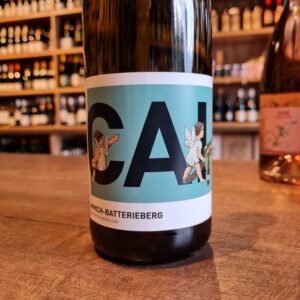 Immich-Batterieberg is one of the oldest wineries in the Mosel; originally founded by a Carolingian monastery, it can be traced back to the year 911. In 1495, the Immich family purchased the property, producing traditional dry and off-dry wines under their name for almost 500 years. The historical estate was then acquired in 2009 by Gernot Kollmann, one of Germany's finest up and comers. He is no stranger to the Mosel, having worked on many prestigious wineries in the region – Dr. Loosen, Weingut Van Volxem and Knebel. Since taking over, he has chosen to retain the long-standing tradition of the winery. The wines are once again produced in a dry or off-dry style, with sugar levels depending on each site, each vintage.80-percent of the vines are un-grafted and over 60 years old, and everything is worked organically. Intervention during vinification is also forbidden. A crisp, crunchy, keenly balanced, TOTALLY DRY trocken style Riesling.
Immich-Batterieberg is one of the oldest wineries in the Mosel; originally founded by a Carolingian monastery, it can be traced back to the year 911. In 1495, the Immich family purchased the property, producing traditional dry and off-dry wines under their name for almost 500 years. The historical estate was then acquired in 2009 by Gernot Kollmann, one of Germany's finest up and comers. He is no stranger to the Mosel, having worked on many prestigious wineries in the region – Dr. Loosen, Weingut Van Volxem and Knebel. Since taking over, he has chosen to retain the long-standing tradition of the winery. The wines are once again produced in a dry or off-dry style, with sugar levels depending on each site, each vintage.80-percent of the vines are un-grafted and over 60 years old, and everything is worked organically. Intervention during vinification is also forbidden. A crisp, crunchy, keenly balanced, TOTALLY DRY trocken style Riesling.


